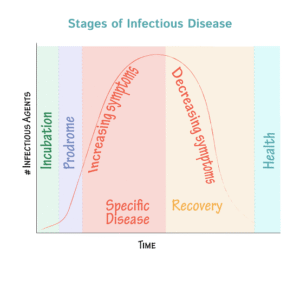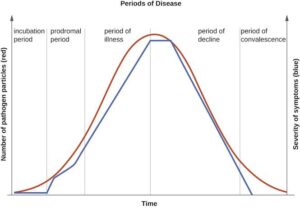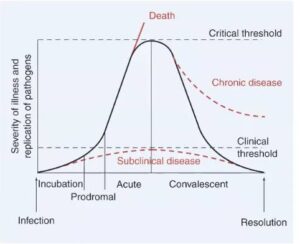Back to: MICROBIOLOGY 100 LEVEL
Welcome to class!
Hello, future scientist! I’m glad you’re here again, ready to build your knowledge step by step. Today, we’ll be talking about how diseases develop in the body and the different stages of infection. Just like a movie has a beginning, middle, and end, infections also have stages—and each stage tells us what’s happening inside the body. Once you understand these stages, you’ll be able to make sense of how infections work and why symptoms come and go.
Disease Development And Stages Of Infection
What Is Disease Development?
Disease development refers to the process by which an infection grows and causes illness in the body. It begins when a microbe enters the body and ends when the infection is cleared or results in serious damage. The body doesn’t get sick immediately after contact with a microbe—there are steps that happen gradually, and these steps are called stages of infection.

Let’s go through them clearly.
1. Incubation Period
This is the silent stage. The microbe has entered the body, but there are no symptoms yet. It is busy multiplying quietly. The length of this stage can vary depending on the microbe and the person’s immune system.
For example, someone who gets exposed to malaria may not feel sick for days or even weeks after the mosquito bite.
2. Prodromal Stage
This is the early warning stage. You may start to feel general symptoms like tiredness, mild fever, headache, or body pain, but nothing specific yet. The body is beginning to realise that something is wrong.
It’s like when NEPA light starts to blink—you know something is about to happen, but you’re not sure what yet.
3. Illness Stage
This is the main stage of infection. Here, the microbe is fully active, and symptoms are clear and strong. If it’s malaria, you may have high fever, chills, and weakness. If it’s typhoid, you might feel stomach pain and prolonged fever.

This is the stage when most people go to the hospital or start medication.
4. Decline Stage
At this stage, your immune system or treatment begins to fight off the infection. The symptoms begin to reduce gradually. Microbes are dying, and the body is recovering.
5. Convalescence Stage
This is the final recovery stage. The infection is gone or nearly gone, but the body may still feel weak and needs time to return to full strength.

Think of it like recovering from a long illness—you feel better but not 100% just yet.
Summary
- Disease development happens in clear steps from entry to recovery.
- Incubation: Microbes multiply silently, no symptoms yet.
- Prodromal: Early mild symptoms begin.
- Illness: Full symptoms appear.
- Decline: Body starts to fight back, symptoms reduce.
- Convalescence: Recovery continues, strength returns.
Evaluation
- What is the incubation period in an infection?
- At which stage do clear symptoms of a disease appear?
- What happens during the decline stage?
- Why is the convalescence stage important?
- List all the stages of infection in the correct order.
With each lesson, you’re getting wiser and more prepared for the future. Keep showing up, stay curious, and remember—Afrilearn is with you every step of the way as you grow into the champion you’re meant to be. Keep going!
